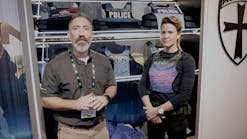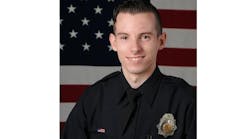Comfort Level
By Mary Erpenbach
Manufacturers meet the growing demand for better women's body armor with new designs, new technology and a unique line of new products
When BAE Systems set out to build better female body armor, the first thing the company did was create another, entirely new, company.
"We wanted a company where we could put 100 percent of our people and financial resources into research and development, into building the body armor from the ground up, for the woman," says Angela Milligan, brand manager for SAVVY Armor.
Devoting an entire company to one product might seem to be an unusual business strategy in this multi-tasking age of diversification, but Milligan says the growing number of women in policing makes it a good decision for SAVVY. Overall, she notes, law enforcement in the United States is already 15 percent female, and that figure runs as high as 25 percent in some cities. Dedicating a brand to female armor, and only female armor, Milligan says, "makes a difference in the designs and in how monies are allocated."
As a result, SAVVY did not attempt to revamp existing body armor products or look for new ways to turn men's vests into women's. "It wasn't about giving women something we already had," she says. "It was about providing them with what they told us they needed." The company's research and development team conducted hundreds of interviews with female officers to get an understanding of what on-the-job women really wanted from their body armor. Then SAVVY designers headed to the drawing board to create the company's own brand of brand-new body armor for women.
Coverage and comfortThe most important information to come from the interviewing process was the fact that many female police officers reported having significant problems with coverage and comfort when it came to their tactical and concealable vests. Women felt "squashed" or "smashed" by the flat fronts of vests that had been designed for men. Alternately, vests that were manufactured with extra room in the front to accommodate women's chests and breasts sometimes revealed gaps in the ballistic fabric on the sides of the vests or under the officers' arms; as a result, women reported that their vests were either uncomfortable, didn't provide proper coverage of their torsos, or both.
Experts have long known that discomfort isn't the only problem caused by wearing a body armor vest that is too flat or snug in front. Wearing an ill-fitting vest for extended periods of time, such as the eight- to 10-hour shifts required by law enforcement, can actually pose a variety of unique health hazards if the wearer is female. Some women patrol officers have reported suffering intense pain after wearing vests for the entirety of their shifts, and in some cases it turned out the pain was caused by irreparable tears to a major ligament within the breast called the Cooper's ligament.
To address women's fit issues, SAVVY designers worked with three different shaping technologies that could be used in the design and manufacture of body armor vests. One of them — radial offset pleating technology — is being used in vests that SAVVY has available now; it was the inaugural technology of the company's October 2007 product-line launch. "The pleats go in a radial all the way from the bust to the bottom of the vest," explains Milligan. "This helps to form a true bust cup, which provides support, and allows for less bulk in the side areas."
In all, SAVVY's current line includes three concealable vests, a tactical vest, seven external carriers, and three specialized vests — one designed for corrections — an ultra-concealable vest for undercover assignments, and a vest for bicycle, personal transport vehicle and motorcycle officers.
Later this year, SAVVY will offer vests that are manufactured using the advanced draping system of the second shaping technology. "The vest actually drapes from the back all the way to the front to provide continuous protection on the sides without the worry of overlapping the front and back panel," Milligan explains. Thermal Forming is the third technology SAVVY will be using to produce women's body armor, and those designs are still in development. "It's a process of heat and pressure that forms a bust cup in the vest," she says. "It's a technology that a lot of people are really excited about."
Fit for femalesMany existing body armor manufacturers and suppliers have long provided female officers with a variety of options in tactical and protective vests. The products offered by companies such as U.S. Armor, Protective Products International (PPI), ForceOne, Armor Express, First Choice Armor and others include vests that are entirely custom designed, custom fitted, or manufactured in both men's and women's cuts. Some manufacturers can adapt existing body armor to fit the needs of female officers and offer customizing services on a case-by-case basis, while others have rolled out lines of products designed specifically for women.
U.S. Armor has a history of providing female officers with body armor. "We've been making women's vests for over 30 years," says U.S. Armor's general manager Georg Olsen. "We've always worked with those suppliers with the longest histories of manufacturing ballistics materials, like DuPont and Honeywell."
As a result, U.S. Armor offers body armor shaped and manufactured specifically for women — a one-piece design that uses darting to shape cups into the front of the vest.
Olsen agrees that seams can indeed create problems when body armor materials are cut in order to reshape a vest — particularly when such reshaping involves creating more room in the front or narrowing the vest near the bottom.
"When you seam armor back together you have to put one piece on top of the other," he explains. "Then you have to back it with armor so nothing goes through the seam, and that can make the vest very bulky and uncomfortable."
PPI also concentrates on body armor for women. In an article on the "Yes Ma'am" Web site — a clearinghouse for women's law enforcement supplies — PPI reports that it also conducted research and field interviews with women officers. In addition, PPI products are available in traditional women's cuts along with products manufactured using radial offset pleating, thermal forming and advanced draping technologies.
ForceOne offers a women's version of vests that are more often made for male officers. "Any of our ballistic packages have a Princess cut available; they're very comfortable and fit very well," says Hank Atkins, president of ForceOne.
Armor Express also offers custom-fit vests for men and women. In addition, the company now features new products just for women officers. "We've been addressing the needs of female officers for quite a few years," says Mary Crawley, marketing coordinator for Armor Express. "Some officers like a vest to completely overlap on the sides, some like it to meet exactly, some like the lower part of the vest to hit the top of their belt buckle. We can accommodate whatever they want."
Armor Express introduced its line of for-women-only body armor earlier this year. "More and more agencies are mandating body armor wear for male and female officers," Crawley notes, "but there are a lot of women out there still wearing men's armor — it's a market that definitely is in need of direct attention." The Armor Express line is manufactured using a specialized darting system that creates built-in cups without cutting the armor, which Crawley says is important because the process does not create seams in the ballistics that could rub or chafe.
Extreme measuresOlsen, too, has watched the demand for female body armor grow in recent years and notes that branches of law enforcement beyond mainstream patrol units have welcomed more women into their ranks. "We're certainly very much aware that there are more women in law enforcement and that there's a need for a specialty product to address the needs that women have and men don't, all across the board," he says.
Chrissy Piper, director of marketing and sales operations for First Choice Armor, says her company's new product, the cap plate, is available in a women's version to serve a different, but no less specialized, branch of law enforcement: the female SWAT officer. "It's kind of like a trauma plate on steroids," she says, "it not only offers special capabilities above and beyond those [specified by] the National Institute of Justice, it also offers knife and blade protection."
First Choice Armor offers a variety of body armor lines that feature male and female products. "Every time we design something, we design it knowing that there are men and women in law enforcement and that they have totally different fit issues," says Piper. The company's Paradigm line of tactical vests, for example, is available in men's and women's fits, as are the company's Synergy Series of concealable vests.
Whether a woman chooses a vest created with new technology or one reshaped from existing templates her best chance at ending up with a well-fitting vest starts with proper measuring. A female officer who hasn't been measured properly will most likely end up with a vest that doesn't fit, say experts, which could result in not wearing the vest at all.
"A vest is only going to be safe if you wear it," says Piper. "And if you're uncomfortable in it or you don't feel like you can do your job in it, then you're less likely to wear it at all." This is true of male and female officers, but Olsen sees some irony when women don't wear their body armor, because surveys have shown that women are more likely to want to wear bullet-resistant vests than are their male colleagues. "The women were the best about wanting to do daily vest wear but in many cases they had the worst choice of equipment," he says. In the past, this was due to the narrow selection of vests available to women. Today, though, the main reason a female officer will toss her vest in the trunk of a patrol vehicle instead of wear it on duty, has to do with improper fit.
"That's one reason the measuring process is extremely important," says Crawley. "Women have to have a certified measuring person who understands the female body. We have a comprehensive, exacting measuring system. People can get embarrassed about providing measurements that run from nipple to nipple and nipple to armpit, but you have to get this information. These measurements are very important."
SAVVY, among others, offers training to female officers on how to measure for female body armor. Many body armor companies, such as First Choice Armor, will also send a measuring professional or a measuring team to a department or an agency on request to measure the female officers who need vests.
Future technologyBody armor companies continue to invest in research and development, looking for the next big thing in bullet-resistant protection technology. Several companies are on the verge of rolling out next-generation products that may well revolutionize the industry.
No company spokespersons want to get too deep into the specifics of what their latest and greatest technology will be. It is true, though, that some of the inventions about to become reality in the body armor industry seem truly space-age compared to the technology that was available to manufacturers only a few years ago.
Liquid body armor, for example, may be one technology that will be on the market soon. It's soft and pliable until something strikes it, at which point it hardens into an impenetrable shell capable of absorbing the impact of a bullet from, for example, a sniper rifle. Nano-fiber and carbon-tube fiber, anywhere from four to 14 times as strong as steel but thinner and lighter than current ballistic materials, is also under development for use in manufacturing both women's and men's body armor.
As a result, it will become easier and more comfortable than ever for women officers — and their male colleagues — to stay safe and vest up.


